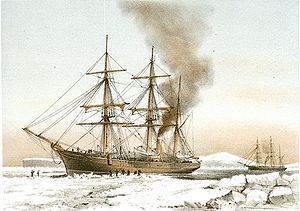Name Bloodhound Completed 1873 Commissioned 13 April 1875 Draft 5.03 m | Yard number 53 Name HMS Discovery Length 51 m | |
 | ||
Acquired Purchased 5 December 1874 | ||
HMS Discovery was a wooden screw storeship, formerly the whaling ship Bloodhound. She was purchased in 1874 for the British Arctic Expedition of 1875–1876 and was sold in 1902.
Contents
Design and Construction
Built in Dundee by Stephens & Sons as the whaler Bloodhound in 1873, she was ideally suited to Arctic exploration. She was purchased by the Admiralty on 5 December 1874 and converted for exploration, commissioning on 13 April 1875. She carried a barque-rig and her Greenock Foundry Company steam engine generated an indicated 312 horsepower.
British Arctic Expedition
Captain George Strong Nares was placed in command of the 1875 British Arctic Expedition, which aimed to reach the North Pole via Smith Sound, the sea passage between Greenland and Canada's northernmost island, Ellesmere Island. Contemporary geographers proposed that there could be an Open Polar Sea, and that if the thick layer of ice surrounding it were overcome, access to the North Pole by sea might be possible. Ever since Edward Augustus Inglefield had penetrated Smith Sound in 1852, it had been a likely route to the North. Nares commanded the converted sloop HMS Alert, and with him went Discovery, commanded by Captain Henry Frederick Stephenson. HMS Valorous carried extra stores and accompanied the expedition as far as Godhavn.
Despite finding heavier-than-expected ice, the expedition pressed on. Leaving Discovery to winter at Lady Franklin Bay, Alert carried on a further 50 nautical miles (93 km; 58 mi) through the Robeson Channel, establishing her winter quarters at Floeberg Beach. Spring 1876 saw considerable activity by sledge, charting the coasts of Ellesmere Island and Greenland, but scurvy had begun to take hold, with Alert suffering the greatest burden. On 3 April the second-in-command of Alert, Albert Hastings Markham, took a party north to attempt the Pole. By 11 May, having made slow progress, they reached their greatest latitude at 83° 20' 26"N. Suffering from snow blindness, scurvy and exhaustion, they turned back.
The expedition returned to the UK in Autumn 1876 and was well rewarded; Nares was knighted, Markham was promoted to Captain. The geography of northern Canada and Greenland is littered with the names of those connected with the expedition; Cape Discovery () on the northern edge of Ellesmere Island is named for the ship.
Storeship at Portsmouth
The Discovery saw no further seagoing service after her return from the Arctic. She was employed as a storeship in Portsmouth Harbour from 1880, probably up until the time of her final disposal.
Disposal
Discovery was sold to D Murray in February 1902.
Legacy
The 1901 research vessel, built for the British National Antarctic Expedition (1901–1904), incorporated many of the features of Discovery, as well as taking her name. RRS Discovery was commanded by Robert Falcon Scott and took part in the Discovery Investigations from 1924 to 1931. She is now on permanent display at Dundee.
Subsequent Royal Research Ships, launched in 1929 and 1962, have also borne the name, as has Space Shuttle Discovery.
